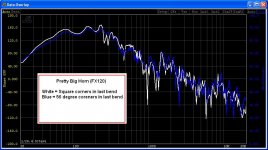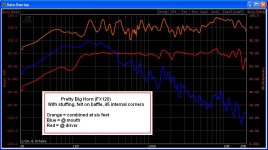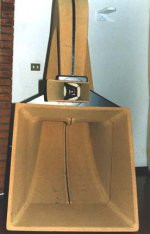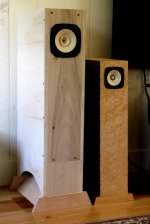FWIW; I generally start with a box size in which I would like to fit and then decide where the mouth will exit; rear, front, bottom. Alternately I sometime start with an existing horn, or even a one segmenet conical horn and start making changes from there.
I start working from the mouth because that is where the cross section is widest and hardest to bend and position. I also try to organize the "wasted" space to be adjacent to the CC so it can be incorporated into the CC for flexibility, if needed.
I mark out the path length center line as I draw the speaker cross section and note widths at major bends. I use this information to draw a straightened out picture of the path on graph paper. I identify the up to four segments that hornresp will accept from the graph paper and calculate segment lengths and areas from the graph.
I next generally then plug the numbers into hornresp and calculate a response. I then fiddle with CC volume and throat size to try to optomize the response.
This is all quite iterative between the speaker cross section drawing, the path length graph and hornresp.
One final note; I always use straight conical sections in hornresp. Conical almost always gives me better response than any of the curved cross section. I don't know if ; 1)this is just the way it works for the type of BLH iIdesign design; 2)a limitation in hornresp or;3) a limitation of my brain (probably 1 and /or 3).
Denis
I start working from the mouth because that is where the cross section is widest and hardest to bend and position. I also try to organize the "wasted" space to be adjacent to the CC so it can be incorporated into the CC for flexibility, if needed.
I mark out the path length center line as I draw the speaker cross section and note widths at major bends. I use this information to draw a straightened out picture of the path on graph paper. I identify the up to four segments that hornresp will accept from the graph paper and calculate segment lengths and areas from the graph.
I next generally then plug the numbers into hornresp and calculate a response. I then fiddle with CC volume and throat size to try to optomize the response.
This is all quite iterative between the speaker cross section drawing, the path length graph and hornresp.
One final note; I always use straight conical sections in hornresp. Conical almost always gives me better response than any of the curved cross section. I don't know if ; 1)this is just the way it works for the type of BLH iIdesign design; 2)a limitation in hornresp or;3) a limitation of my brain (probably 1 and /or 3).
Denis
A proper BLH will have a hyperbolic expansion and since the faster expanding part towards the mouth will be truncated, two or three conic segments will define it close enough. Even if a traditional expo, it can be approximated with octave wide conic segments.
GM
GM
Hi GM, I apologize for my ignorance but does folding a horn in half give you two "octave wide" segments? (I have not heard the term "octave wide" before so I'm trying to guess.)
Greets!
No, an octave is a 2:1 spread, i.e. 100/200/400/800, etc., so each one is shorter than the previous one and since the leading edge of a note has the furthest to travel, the highs are the first to leave the horn's throat, expanding to the lows at the mouth. From this we see that the first section will be the longest, so in compact designs it's typically divided up into a number of sections to not only make it compact, but to keep the mids, HF from reflecting back to the throat, i.e. make the first few bends < ~1/3 WL of the desired HF acoustic XO point.
GM
No, an octave is a 2:1 spread, i.e. 100/200/400/800, etc., so each one is shorter than the previous one and since the leading edge of a note has the furthest to travel, the highs are the first to leave the horn's throat, expanding to the lows at the mouth. From this we see that the first section will be the longest, so in compact designs it's typically divided up into a number of sections to not only make it compact, but to keep the mids, HF from reflecting back to the throat, i.e. make the first few bends < ~1/3 WL of the desired HF acoustic XO point.
GM
Ever wonder if "rounding" off corners in a BLH makes a difference? I forgot to put in the 45 degree angles in the last bend before the mouth when I took my first measurements. I just put them in and took the mouth measurements again. You can see that it made a pretty significant improvement in the 200-350 hz region.
Attachments
Pretty Big Horn with FE166E
Here it is with an FE166E mounted on an interchangeable baffle and standing next to the Little Big Horn for a size comparison. The volume is just about double. I've done some preliminary listening with both the FX120's and the FE166E's. The first thing that is obvious is that the PBH with either driver has much more bass than the little brother.
Here it is with an FE166E mounted on an interchangeable baffle and standing next to the Little Big Horn for a size comparison. The volume is just about double. I've done some preliminary listening with both the FX120's and the FE166E's. The first thing that is obvious is that the PBH with either driver has much more bass than the little brother.
Attachments
- Status
- Not open for further replies.
- Home
- Loudspeakers
- Full Range
- Pretty Big Horn



